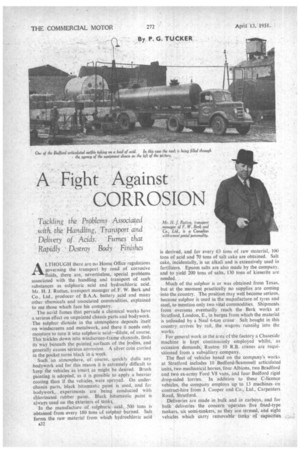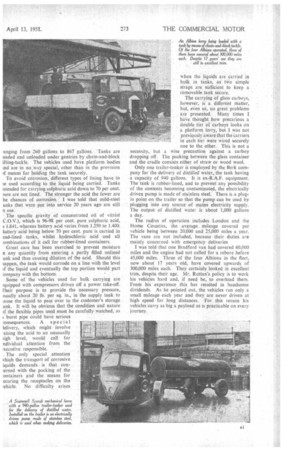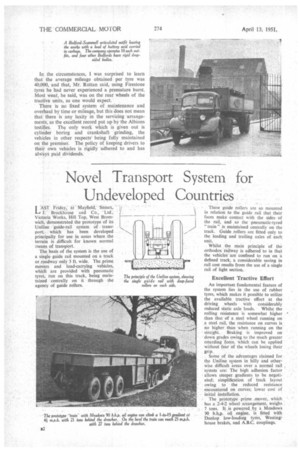• A Fight Against CORROSION
Page 34

Page 35

Page 36

If you've noticed an error in this article please click here to report it so we can fix it.
Tackling othe Problems Associated t /1the Handling, Transport and Delivery of Acids. Fumes that Rapidly Destroy Body Finishes ALTHOUGH there are no Home Office regulations governing the transport by road of corrosive fluids, there are, nevertheless, special problems associated with the handling and transport of such substances as sulphuric acid and hydrochloric acid. Mr. H. J. Ruttan. transport manager of F. W. Berk and Co., Ltd., producer of B.A.A. battery acid and many other chemicals and associated commodities, explained to me those which face his company.
The acrid fumes that pervade a chemical works have a serious effect on unpainted chassis parts and bodywork. The sulphur dioxide in the atmosphere deposits itself on windscreens and metalwork, and there it needs only moisture•to turn it into sulphuric acid—dilute, of course. This Wades down into windscreen-frame channels, finds its yvay. beneath the painted' surfaces of.the bodies, and generally causes serious corrosion. A silver coin carried in the pocket turns black in-a week. . .
Such an atmosphere, of course, quickly dulls any bodywork and for this reason i,t is extremely difficult to keep the vehicles as Smart as might be desired. Brush painting is adopted.; as it is possible to apply,a heavier coating than if the vehicles were sprayed. On under chassis parts, black bitumastic paint is used, and for bodywork,., experiments are being conducted with Chlorinated rubber paint, Black bitumastic paint is always used on the eXteriors of tank.
In the manufacture. of, sulphuric acid, 500 tons is obtained from every 180 tons of sulphur burned. Salt forms the raw material from which hydrochloric acid A32 is derived, and for every 63 tons of raw material, 100 tons of acid and 70 tons of salt cake are obtained. Salt cake, incidentally, is an alkali and is extensively used in fertilizers. Epsom salts are also made by the company, and to yield 200 tons of salts, 130 tons of kieserite are needed.
Much of the sulphur is or was obtained from Texas. but at the moment practically no supplies are coming into the country. The position may well become serious. because sulphur is used in the manufacture of tyres and steel, to mention only two vital commodities. Shipments from overseas eventually reach the Berk works at Stratford, London, E., in barges from which the material is unloaded by a Neal 6-ton crane Salt bought in this country arrives by rail, the wagons runniiv into the works.
For general work in the area cf the factory a Chaseside machine is kept continuously employed whilst, as occasion demands, Ruston 10 R.B. cranes are requisitioned from a subsidiary company.
The fleet of vehicles based on the company's works at Stratford includes 10 Bedford-Scammell articulated units, two mechanical horses, four Albions, two Bradford and two ex-army Ford V8 vans, and four Bedford rigid drop-sided lorries. In addition to these C-licence vehicles, the company employs Up to 13 machines on contract-hire from 3. Cooper and Co., Ltd., Carpenters Road, Stratford.
Deliveries are made in bulk and in carboys, and for bulk deliveries the concern operates five fixed-type tankers, six semi-tankers, as they are termed, and eight vehicles which carry removable tanks of capacities
anging from 260 gallons to 867 gallons. Tanks are oaded and unloaded under gantries by chain-and-block ifting-tackle. The vehicles used have platform bodies Ind are in no way special, other than in the provision )f means for holding the tank securely.
To avoid corrosion, different types of lining have to ae used according to the liquid being carried. Tanks
ntended for C3rrying sulphuric acid down to 70 per cent. mre are not lined. The stronger the acid the fewer are he chances of corrosion. I was told that mild-steel anks that were put into service 20 years ago are still
n use.
The specific gravity of concentrated oil of vitriol C.O.V.), which is 96-98 per cent. pure sulphuric acid, s 1.841, whereas battery acid varies from 1.250 to 1.400. lattery acid being below 70 per cent. pure is carried in cad-lined tanks, whilst hydrochloric acid and all :ombinations of it call for rubber-lined containers.
Great care has been exercised to prevent moisture
n any quantity from entering a partly filled unlined
ank and thus causing dilution of the acid. Should this lappen, the tank would corrode on a line with the level
■ f the liquid and eventually, the top portion would part :ompany with the bottom.
Some of the vehicles used for bulk carrying are :quipped with compressors driven off a power take-off.
['heir purpose is to provide the necessary pressure, isually about 20 lb. per sq. in., in the supply tank to :ause the liquid to pass over to the customer's storage anik. It will be obvious that the condition and nature
ff the flexible pipes used must be carefully watched, as t burst pipe could have serious
:onsequences. A special lelivery, which might involve aising the acid to an unusually iigh level, would call for ndividual attention from the :xecutive responsible.
The only special attention vhich the transport of corrosive iquids demands • is that con :erned with the packing of the • ontainers and the means for ecuring the receptacles on the Thiele. No difficulty arises when the liquids are carried in bulk in tanks, as to simple straps are sufficient to keep a removable tank secure.
The carrying of glass carboys, however, is a different matter, but, even so, no great problems , are presented. Many times I have thought how precarious a double tier of carboys looks on a platform lorry, but I was not previously aware that the carriers in each tier were wired securely one to the other. This is not a necessity, but a wise precaution against a carboy dropping off. The packing between the glass container and the cradle consists either of straw, or wood wool.
Only one trailer-tanker is employed by the Berk company for the delivery of distilled' water, the tank having a capacity of 940 gallons. It is ex-R.A.F. equipment. The tank is rubber-lined, and to prevent any possibility of the contents becoming contaminated, the electrically driven pump is made of stainless steel. There is a plugin point on the trailer so that the pump can be used by plugging into any source of mains electricity supply. The output of distilled water is about 1,000 gallons a day.
The radius of operation includes London and the Home Counties, the average mileage covered per vehicle being between 20,000 and 25,000 miles a year. The vans are not included, because their duties are mainly concerned with emergency deliveries I was told that one Bradford van had covered 60,000 miles and the engine had not called for a rebore before 45,000 miles. Three of the four Albions in the fleet, now about 17 years old, have covered upwards of 300,000 miles each. They certainly looked in excellent trim, despite their age. Mr. Ruttan's policy is to work his vehicles hard and, if need be, to overload them. From his experience this has resulted in handsome dividends. As he pointed out. .the vehicles run only a small mileage each year and they are never driven at high speed for long distances. For this reason his vehicles carry as big a payload as is practicable on every journey.
In the circumstances, I was surprised to learn that the average mileage obtained per tyre was 40,000, and that, Mr. Ruttan said, using Firestone tyres he had never experienced a premature burst. Most wear, he said, was on the rear wheels of the tractive units, as one would expect.
There is no find system of maintenance and overhaul by time or mileage, but this does not mean that there is any laxity in the servicing arrangements, as the excellent record put up by the Albions testifies. The only Work which is given out is cylinder boring and crankshaft grinding, the vehicles in other respects being fully maintained on the premises. The policy of keeping drivers to their own vehicles is rigidly adhered to and has alWayS paid dividends.












































































